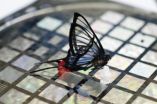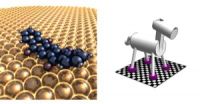(Press-News.org) Gainesville, FL. -- The first genetic study to compare nuclear DNA of endangered Antillean manatees in Belize with Florida manatees confirmed their designation as separate subspecies. Belize's manatees, however, were found to have extremely low genetic diversity, raising questions about their long-term genetic viability.
The Central American country of Belize hosts the largest known breeding population of Antillean manatees and is touted by biologists for its potential to repopulate other parts of Central America where manatees are severely reduced, rare or absent.
"It turns out that the genetic diversity of Belize's manatees is lower than some of the classic examples of critically low diversity" said U.S. Geological Survey (USGS) conservation geneticist Margaret Hunter, Ph.D., who led a molecular DNA study of genetic diversity in the Antillean subspecies in Belize.
Belize's Antillean populations scored lower in genetic diversity than textbook examples of "bottlenecked" endangered species such as Wanglang giant pandas, the East African cheetah and an island koala population founded by only three koalas.
Endangered species need genetic diversity to weather threats to their survival, including random or rare shocks such as disease, hurricanes or habitat destruction. When a population drops to low numbers, the diversity of its gene pool also shrinks. Even after it rebounds to greater numbers, that population decline leaves a legacy of reduced genetic diversity known as a bottleneck. This renders the population more vulnerable to future shocks, explained Hunter.
The low genetic diversity in Antillean manatees is attributed, in part, to centuries of hunting that were only curtailed early in the 20th century. Once found throughout coastal regions of Central and South America, Antillean manatees are now rare or absent in parts of Central America where they used to be considered abundant. Today, even Belize only hosts about 1,000 individuals — a number well below the threshold recommended for long-term sustainability, said Hunter.
Distinct Populations Offer Opportunity
Although the study found low overall genetic diversity in Belize, notable differences were found in manatees that live near Belize City compared to manatees living in lagoons, rivers, and cayes farther south. These differences, said Hunter, equate to genetic variation, which is valuable for sustaining a diverse gene pool.
"When it comes to the sustainability of a species, this is the type of genetic diversity you want to preserve for the future," explained Hunter.
To sustain the diverse gene pool these populations offer, managers will need to consider methods of enabling natural migration and mixing to take place between the two populations.
"These results show the importance of corridors of suitable habitat and low human impact that allow manatees to travel between key sites," said co-author Nicole Auil Gomez, a Belizean biologist who does consulting for the Florida-based conservation organization Sea 2 Shore Alliance.
"Leaving pockets of habitat is no longer enough," she added.
Confirmation of the Subspecies
The genetic evidence that Florida manatees (Trichechus manatus latirostris) are not regularly mixing with populations of Antillean manatees (Trichechus manatus manatus) in Belize means they don't naturally affect each other's population size or genetic diversity, Hunter said.
The question of whether these two seemingly distant populations were interbreeding had been raised in light of radiotracking evidence that manatees are capable of migrating long distances. Florida manatees have turned up in places as far as Rhode Island, the Bahamas and Cuba.
The only prior genetic data comparing the subspecies came from mitochondrial DNA, which is useful for understanding historical relationships on an evolutionary time scale (think millennia, not decades). By including nuclear DNA, this study provided a modern-day assessment of whether the two populations are migrating and interbreeding.
"We are continuing to piece together the genetic relationships of manatees throughout the Caribbean and it's giving us insights into how to maintain healthy and stable populations," said USGS biologist and co-author Bob Bonde, Ph.D.
The study, Low genetic variation and evidence of limited dispersal in the regionally important Belize manatee, was recently published in the journal Animal Conservation.
INFORMATION:
More information about USGS research on manatee genetics can be found on the USGS Sirenia Project website.
USGS provides science for a changing world. Visit USGS.gov, and follow us on Twitter @USGS and our other social media channels.
Subscribe to our news releases via e-mail, RSS or Twitter.
Links and contacts within this release are valid at the time of publication.
When looking for a new physician, patients are often encouraged to select those who are board certified or who have not made payments on malpractice claims. Yet these characteristics are not always a good predictor of which physicians will provide the highest quality medical care, according to a new study from the RAND Corporation, a nonprofit research organization, and the University of Pittsburgh School of Medicine.
"We found that the types of information widely available to patients for choosing a physician do not predict whether that physician will deliver evidence-based ...
An unusual wildflower that accumulates metals in its leaves has been found to use them as a kind of 'armor' against bacterial infection. Scientists from Oxford University have shown that when Alpine pennycress (Thlaspi caerulescens) plants accumulate metals in their leaves, they become resistant to attack by the bacterium Pseudomonas syringae pv. maculicola. They report their findings September 9 in the open-access journal PLoS Pathogens.
Thlaspi, a small plant in the mustard family that grows on metal-rich soils scattered around Britain and Europe, such as the sites ...
VIDEO:
Artificial skin for people and robots could be a reality using the ultra-sensitive sensors developed by Zhenan Bao, associate professor of chemical engineering at Stanford University, and her team. The...
Click here for more information.
The light, tickling tread of a pesky fly landing on your face may strike most of us as one of the most aggravating of life's small annoyances. But for scientists working to develop pressure sensors for artificial skin for use on ...
RIVERSIDE, Calif. – Molecular machines can be found everywhere in nature, for example, transporting proteins through cells and aiding metabolism. To develop artificial molecular machines, scientists need to understand the rules that govern mechanics at the molecular or nanometer scale (a nanometer is a billionth of a meter).
To address this challenge, a research team at the University of California, Riverside studied a class of molecular machines that 'walk' across a flat metal surface. They considered both bipedal machines that walk on two 'legs' and quadrupedal ones ...
(NEW YORK, NY, September 13, 2010) – A new study led by researchers at Columbia University Medical Center has identified a novel molecular pathway underlying Parkinson's disease and points to existing drugs which may be able to slow progression of the disease.
The pathway involved proteins – known as polyamines – that were found to be responsible for the increase in build-up of other toxic proteins in neurons, which causes the neurons to malfunction and, eventually, die. Though high levels of polyamines have been found previously in patients with Parkinson's, the new ...
Durham, NH—September 13, 2010— During the recent recession in the United States, many industries suffered significant layoffs, leaving individuals and families to revise their spending and rethink income opportunities. Many wives are increasingly becoming primary breadwinners or entering the labor market. A new article in Family Relations tests "the added worker" theory, which suggests wives who are not working may seek work as a substitute for husband's labor if he becomes unemployed, and finds that during a time of economic downturn wives are more likely to enter the ...
VIDEO:
Years of research has proven that saturated and trans fats clog arteries, make it tough for the heart to pump and are not valuable components of any diet. Unfortunately, they...
Click here for more information.
COLUMBIA, Mo. ¬— Years of research has proven that saturated and trans fats clog arteries, make it tough for the heart to pump and are not valuable components of any diet. Unfortunately, they are contained in many foods. Now, a University of Missouri research ...
Montreal / September 13, 2010 – September 21, 2010 marks the one year anniversary of the release of a landmark document produced by researchers at Concordia University. Mobilizing The Will to Intervene (W2I) offers governments practical steps to prevent future genocides and mass atrocities. Produced by researchers with the Montreal Institute for Genocide and Human Rights Studies (MIGS) based at Concordia, the document was presented to the governments of Canada and The United States of America. It has already yielded concrete results.
Under President Barack Obama's leadership, ...
The National Institute on Drug Abuse (NIDA), part of the National Institutes of Health, announced today that Dr. Eric M. Verdin of the J. David Gladstone Institutes in San Francisco, Calif., has been selected as the 2010 recipient of the NIDA Avant-Garde Award for HIV/AIDS Research for his proposal to study the mechanisms of latent HIV infection. NIDA's annual Avant-Garde award competition, now in its third year, is intended to stimulate high-impact research that may lead to groundbreaking opportunities for the prevention and treatment of HIV/AIDS in drug abusers. Awardees ...
WASHINGTON — A new look at tests of mental aging reveals a good news-bad news situation. The bad news is all mental abilities appear to decline with age, to varying degrees. The good news is the drops are not as steep as some research showed, according to a study published by the American Psychological Association.
"There is now convincing evidence that even vocabulary knowledge and what's called crystallized intelligence decline at older ages," said study author Timothy Salthouse, PhD.
Longitudinal test scores look good in part because repeat test-takers grow familiar ...


